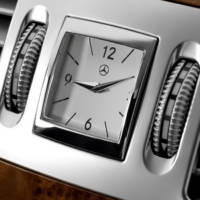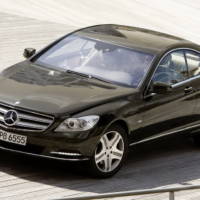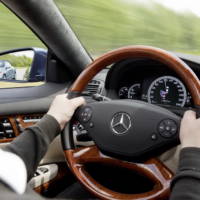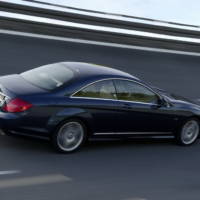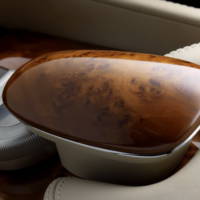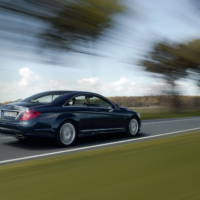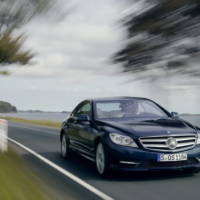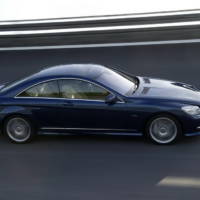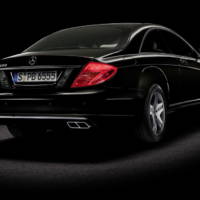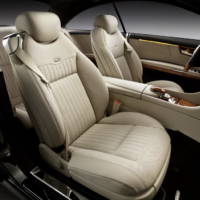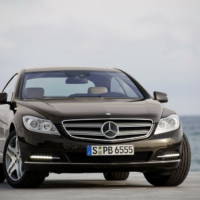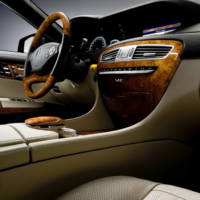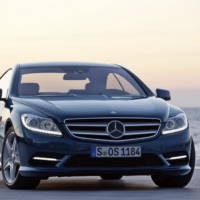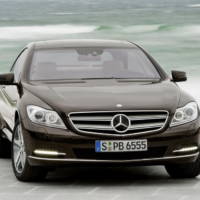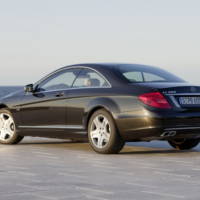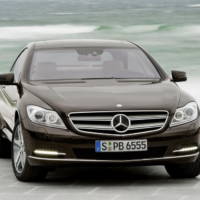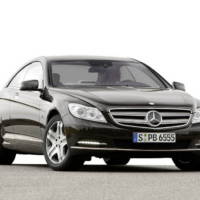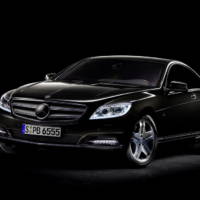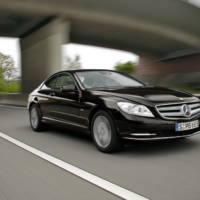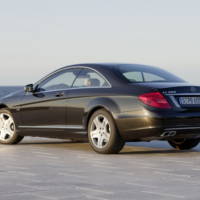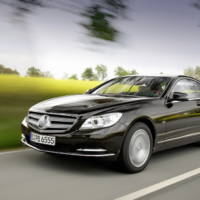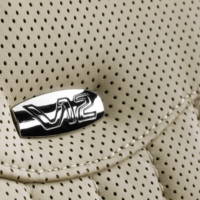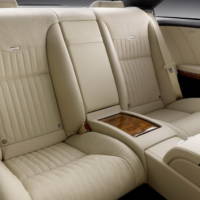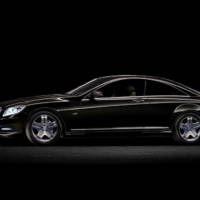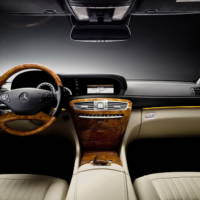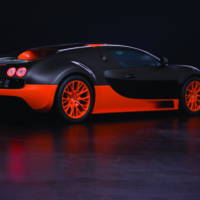The facelift version 2011 Mercedes CL was unveiled during the weekend, and besides a mild exterior refresh, the company’s luxury coupe has also received a new Bi-Turbo V8 engine.
So starting with the visual improvements the 2011 Mercedes CL facelift features a redesigned front bumper that integrates the LED daylight runing lights, new headlamps also incorporating LEDs, a new bonnet, a revamped front grille plus new taillights.
Inside the 2011 Mercedes CL facelift the automaker adds new color materials plus a redesigned steering wheel covered in wood and leather.
As for the new V8 engine option, this 4.7-litre Bi-Turbo unit with BlueDIRECT technology is fitted on the 2-11 Mercedes CL500 and will be linked to a 7-speed automatic transmission that has Stop-Start and brake energy recovery.
Thanks to this engine the 2011 Mercedes CL500 will output 429 HP and 516 lf-ft of torque, which means it can accelerate from 0 to 62 mph in 4.9 seconds and reach a limited top speed of 155 mph.
The 2011 Mercedes CL price will get announced as we get closer to the on sale date and the performance versions 2011 Mercedes CL63 AMG and CL65 AMG will also get revealed towards the end of 2010.
Daimler press release :
The new generation Mercedes-Benz CL-Class: The epitome of luxury coupés
With a design perfected through an immaculate sense of style, highly exclusive appointments and cutting-edge technology, the extensively updated Mercedes-Benz CL-Class underscores its claim to supremacy as the summit of automotive refinement. The entirely re-designed 320 kW (435 hp) V8 biturbo engine of the CL 500 BlueEFFICIENCY, with a combined consumption of 9.5 litres premium-grade petrol per 100 km, opens a new dimension of efficiency in the luxury coupé category. Its NEDC figures show savings of up to 23 percent over its predecessor model, CO2 emissions having dropped from 288 grams per kilometre to 224 grams per kilometre. This significant reduction is achieved thanks to the newly-developed BlueDIRECT technology with third-generation spray-guided direct injection, with the contribution of the specially-designed BlueEFFICIENCY package of the CL 500 BlueEFFICIENCY. The package includes, among other things, energy-efficient control of alternator, fuel pump, air-conditioning compressor and power-assisted steering system, as well as the ECO start/stop function. It also features the use of low rolling resistance tyres and the energy-optimised Active Body Control system. In addition, the Mercedes-Benz developers equipped the CL-Class with state-of-the-art multimedia technology, thus helping this model, produced with a high proportion of hand-finished work, to retain its position as the epitome of quality in its class.
With the new generation of the CL-Class, the Stuttgart-based automaker focuses on fuel consumption and exhaust gas emissions in the exclusive high-end segment, too. According to Dr Dieter Zetsche, Chairman of the Board of Management of Daimler AG: “The CL is the ideal ambassador for our brand. It combines in a particular degree those things that characterise Mercedes-Benz: fascination, perfection and responsibility. And with the new generation we have gone a step further, too – especially in the realm of efficiency. But in terms of design, safety, comfort and output, too – the CL shows the way forward: simply follow Mercedes”
In addition, a combination of cutting-edge camera and radar-based assistance systems unique in the luxury coupé segment, including the innovation of the Active Lane Assist and Active Blind Spot Assist systems, makes of the CL-Class a "thinking" partner of the driver. The modified Active Body Control (ABC) with crosswind stabilisation system and the Direct-Steer system also contribute to enhancing safety and driving enjoyment.
Design: a muscular, self-assured presence
The exterior appearance of the new CL-Class generation is characterised by the terse profile of the bonnet, the dynamic V-shape radiator grille and the curving headlamps – design details that discreetly but effectively emphasise the car’s elegant yet powerful lines.
The front bumper, too, presents a new design with three air intake openings and a chrome trim strip. An LED strip with chrome surround for the daytime running lights is elegantly integrated in the side openings for the brake cooling air. With their standard-fit Intelligent Light System (ILS) and Adaptive Highbeam Assist, the headlamps offer state-of-the-art illumination technology. The latest LED technology in the turn indicators and position marker lamps rounds off the car’s advanced image. The rear of the vehicle is characterised by the newly-designed tail lamps.
New V8 bi-turbo engine with innovative technology
The new-generation CL-Class also assumes a pioneering role in the drive system sector. Under the bonnet of the CL 500 BlueEFFICIENCY and CL 500 4MATIC BlueEFFICIENCY a new V8 biturbo engine with BlueDIRECT technology delivers its impressive power. With its 4663 cc displacement, the eight-cylinder engine produces 320 kW (435 hp) so that despite 0.8 litres less displacement, it is still around 12 percent more powerful than its predecessor, which had an output of 285 kW (388 hp). At the same time, torque was raised from 530 Nm to 700 Nm – an increase of 32 percent. Combined consumption in the New European Driving Cycle (NEDC), on the other hand, drops by 23 percent to 9.5 litres of premium petrol per 100 kilometres for the rear-wheel drive version. CO2 emissions consequently sink from 288 grams per kilometre to 224 grams per kilometre. The CL 500 BlueEFFICIENCY requires a mere 4.9 seconds to accelerate from a standstill to 100 km/h (previous model: 5.4 seconds). Summing up: the CL 500 BlueEFFICIENCY is significantly more agile, torquey and thriftier than its predecessor.
The BlueDIRECT technology package of the V8 biturbo includes a series of new developments, unique in their combination. Worthy of mention among these is the third-generation spray-guided direct petrol injection with piezo injectors and multi-spark ignition with up to four ignition sparks within a millisecond. Together both enable an innovative combustion process called "homogenous split". Other factors contributing to the exemplary low fuel consumption continue to be the consistent use of friction-optimised pistons, piston rings and cylinder barrels, the on-demand control of oil pump and the new three-phase thermal management in the coolant circuit. The luxury coupé’s package includes the ECO start/stop function and alternator control in accordance with the handling situation and on-board voltage with kinetic energy recuperation in overrun mode.
The CL 600, with its 380 kW (517 hp) 12-cylinder biturbo engine remains the top-of-the-line model: it accelerates the luxury coupé from a standstill to 100 km/h in breath-taking 4.6 seconds and now also complies with the Euro 5 emissions control standard.
A unique combination of driver-assistance systems
The new-generation CL-Class consolidates its position as an automotive masterwork and a technology platform of the Stuttgart-based company with the most advanced assistance and protection systems. These highly perceptive assistants convert the Mercedes model into a "thinking" partner that can see, feel and react instantly if it detects a hazard, acting autonomously to prevent accidents or to mitigate their effects. The trailblazing driver assistance systems in the CL-Class are based on state-of-the-art radar, camera and sensor technology.
Thus, in the new-generation CL-Class Active Lane Keeping Assist celebrates its premiere (at the same time as in the S-Class). If the vehicle threatens to cross a continuous lane marking line, the system actuates an electric motor in the steering wheel, causing it to vibrate briefly – giving the driver a discreet but effective warning hint to countersteer immediately. The active system springs into action if the Mercedes coupé unintentionally crosses a continuous lane marking line to the right or to the left. In this case, it intervenes by gently braking the wheels of the opposite side of the car, helping the driver to stay in the lane. In order to do this Active Lane Keeping Assist avails itself of the ESP® Electronic Stability Program.
Active Lane-Keeping Assist evaluates information provided by a camera mounted on the inside of the windscreen. It identifies the contrast between the road surface and the lane marking lines. In addition to this, using radar the system scans the side of the roadway for crash barriers and other roadway edge markings. This Mercedes assistance system also evaluates the driver’s actions and can thus reliably determine whether the car is departing from the lane intentionally or not. For this reason, there is no warning if the driver accelerates hard just before overtaking or when accessing a motorway, or if he brakes hard or steers into a curve.
Targeted brake actuation: active Blind Spot Assist
A further innovation Mercedes-Benz offers for the CL-Class is active Blind Spot Assist, a system that makes use of a multi-stage warning concept. If it detects that a change of lane would be too dangerous, it warns the driver by displaying a red triangle in the glass of the exterior mirror. Close-range radar sensors monitor the area immediately to the side and to the rear of the car. If the driver disregards this warning and, for example, actuates the turn indicator, an audible warning also sounds. If the driver continues to ignore the warnings and comes dangerously close to a vehicle in the neighbouring lane, a novel feature of the system acts: a corrective braking intervention via ESP® on the wheels of the opposite side of the vehicle. This causes a yaw movement about the car’s vertical axis due to the unequal distribution of the braking forces. If despite this course correction an accident cannot be avoided, the active Blind Spot Assist system can reduce the consequences of a collision through the brake actuation.
Assistants to see and be seen better
Adaptive Main Beam Assist is another standard-fit system featured by the CL-Class. This camera-based system can recognise oncoming vehicles or vehicles ahead with their lights on, and then controls the headlamps to ensure the best possible beam range without dazzling other road users. In addition, Mercedes-Benz offers the Night View Assist PLUS system for the CL-Class, featuring a special infra-red camera for pedestrian detection: as soon as the system detects pedestrians on the road ahead, these are highlighted additionally in the display, in order to catch the driver’s attention better.
The images supplied by the windscreen camera are also used by the new, optional Speed Limit Assist, which recognises speed limit signs in passing and shows the relevant speed limit in the central display and on the navigation system’s map display (standard for CL 600).
For the new-generation CL-Class, Mercedes-Benz has also improved the long and medium-range radar used by Brake Assist (BAS PLUS) and DISTRONIC PLUS proximity cruise control.
An "electronic crumple zone": the PRE-SAFE® Brake
Mercedes-Benz also offers another radar based system for the luxury coupé as a component of the driver assistance package PLUS in the form of the PRE-SAFE® Brake. If the driver is distracted and fails to recognise the imminent danger of a rear-end collision or the warning signal of an assistance system, this system can intervene and brake the vehicle independently. If the driver fails to react even after automatic, partial braking action, this most recent development stage of the PRE-SAFE® Brake activates the maximum braking pressure around 0.6 seconds before what it now recognises as an unavoidable collision – an emergency braking action that can significantly mitigate the severity of the impact. The PRE-SAFE® Brake thus acts as a kind of "electronic crumple zone".
Warns driver of overtiredness: ATTENTION ASSIST
Overtiredness is one of the most common causes of accidents. This is why Mercedes experts have developed the ATTENTION ASSIST system which forms part of the standard equipment of the new generation CL-Class. As the vehicle is being driven, the system continuously evaluates more than 70 different parameters in order to identify driver drowsiness and provide a warning before the dangerous microsleep phase begins. Observing the driver’s steering behaviour has proved to be a particularly strong indicator: several years of practical research by Mercedes-Benz have shown that drowsy drivers make minor steering errors which they often correct very rapidly in a characteristic way. This steering behaviour is recognised by a special steering angle sensor. Observing the driver’s eyes cannot always provide conclusive evidence of sleep since many drivers can experience micro-sleep with their eyes open.
Active Body Control reduces the effect of a crosswind
The CL-Class also meets the highest standards in terms of driving dynamics and agility. This is in part thanks to Direct-Steer, with a steering ratio that varies with the steering angle, and modified Active Body Control (ABC) with crosswind stabilisation (standard for CL 500 BlueEFFICIENCY and CL 600). This latest stage in active body development modifies the wheel load distribution via the ABC spring struts within milliseconds, depending on crosswind direction and intensity, to the extent that it can largely compensate the effects of the crosswind.
The Active Body Control suspension system with which Mercedes-Benz ushered in new dimensions of driving dynamics in the preceding C 215 model series in 1999, is unique worldwide as it not only regulates roll, but pitching and squatting movements as well, ensuring a perfect harmony of comfort and handling stability. Since the introduction of this innovative system, engineers in Sindelfingen have continuously improved on it, so that eleven years later it still marks the summit of automotive engineering. In addition to crosswind stabilisation, the new suspension features an energy-optimised hydraulic pump that takes part of the burden off the engine, contributing towards reducing fuel consumption.
Additional safety and agility at the physical limits is provided by the standard-fit Torque Vectoring Brake in the new-generation CL-Class – targeted, one-sided braking intervention at the inside rear wheel when cornering. This enables the luxury coupé to turn into the bend under precise control with even greater agility.
On-board infotainment: the most advanced multimedia technology
In line with its serene character and claim to be a technological masterwork, the CL-Class also sets standards where onboard infotainment is concerned. Thus, the Stuttgart automotive manufacturer equips its flagship model with the new SPLITVIEW technology for the COMAND control and display system centrally located in the centre console (standard for the CL 600 in conjunction with Front Seat Entertainment package). This innovative display concept allows the driver and front passenger to view different contents simultaneously on one and the same screen. While the driver e.g. uses the map-based navigation system, the front passenger can be watching a film on DVD.
The standard COMAND control and display system with Bluetooth®, USB and SD card interfaces offers customers the possibility of exporting their stored data to other vehicles and multimedia devices. It is also possible to transfer and update navigation data. In the glove compartment Mercedes-Benz integrates as optional equipment the Media Interface – an interface for mobile audio and video devices – devices such as the iPod® and every other possible customer device.
The optional Navigation package with COMAND APS (standard for the CL 600) features a Europe-wide navigation system whose data are stored on a 40-Gigabyte hard disc, enabling extremely rapid route calculation. Another factor contributing to a high level of navigation comfort is the detailed three-dimension map display including updates free of charge for three years. For musical entertainment COMAND APS provides a radio, a CD/DVD player with MP3 function, an equalizer with speed-dependent volume control and the MUSIC REGISTER with a 7.2 GB hard disc which stores around 2500 digital music files in MP3, AAC or WMA format. The system recognises music files played on CD, DVD or from the MUSIC REGISTER using its stored Gracenote® database, and shows the title, album and performer in the colour display. Another new function, Music Search, enables CL-Class drivers and passengers to search SD memory cards, USB sticks, CDs and DVDs for specific music titles and performers.
The Navigation package also includes the latest-generation LINGUATRONIC voice control system that controls the navigation, telephone and audio devices via whole-word input. Benefit: the driver no longer needs to spell out his commands but simply speaks the corresponding words as whole words when entering the destination or choosing a radio station or a music title from the Music Register, or when calling up a name from the phone book.
The further developed surround sound system with Discrete Logic7® technology developed by Mercedes-Benz together with audio specialists Harman Kardon® delivers an outstanding performance with three-dimensional sound as a natural 360-degree musical experience for all passengers of the CL-Class. Mercedes-Benz offers the surround sound system together with SPLITVIEW and a six-disc DVD changer as part of the Entertainment Package (standard for CL 600).
Interior: carefully selected materials and first-class finish
In the interior, too, Mercedes-Benz developers and designers perfected the CL-Class, paying careful attention to detail. A total of four different kinds of fine wood open up the possibilities for perfectly matched material and colour concepts according to your personal taste: apart from light and dark high-gloss burr walnut, there is black ash and high-gloss brown poplar (CL 600). Another particularity: in line with the central importance awarded to the concept of sustainability within the Mercedes-Benz corporate philosophy, the CL-Class employs only European wood from renewable forestry sources. Most of the wood parts are hand-made and matched individually for colour and grain by experienced craftsmen.
The seat covers of the new CL-Class are of the most exquisite quality. For this luxury model there are two different kinds of leather available which thanks to their low pre-tensioning and consequent wrinkle effect appear supple and comfortable from the very first glance. There is a choice of five tasteful colour combinations for the vehicle interior: black/black, savannah beige/cashmere beige, sahara beige/black, and the novel combinations alpaca grey/basalt grey and aubergine/black.
The multifunction steering wheel of the CL-Class has also been modified by the Mercedes-Benz designers: in future the rim and airbag module are lined with soft nappa leather as standard. The new, flatter airbag module also lends a sporty touch to the multifunction steering wheel covered in leather sewn with sophisticated double stitching.
Apart from this, Mercedes-Benz makes more use of light as a styling element in the vehicle interior. In future customers who specify the optional ambient lighting (standard for CL 600) have a choice between three lighting moods: solar (amber), neutral (white) and polar (ice blue).
Tradition: an exclusive line of ancestors
The new generation CL-Class continues the great tradition of Mercedes-Benz coupés, which reaches back to the legendary supercharged cars of the 1920s and ’30s. Since the 1950s in particular, the brand with the three-pointed star has produced an uninterrupted series of exclusive two-door cars which combine sophisticated design with trailblazing technology – every model an automotive classic. The W 188 model series 300 S Coupé which entered series production in 1952 marked the beginning. A contemporary report called it the "measure of what it is possible to achieve in automotive engineering".
This statement has retained its full validity for all subsequent models, right down to the current CL-Class of model series C 216, because the luxury coupés from Mercedes-Benz featured – apart from their timeless design and the highest level of comfort – trailblazing innovations in automotive technology. Thus it was that in 1961 the 220 SE Coupé was the first series-production Mercedes-Benz to be equipped with disc brakes. In 1995 the ESP Electronic Stability Program celebrated its world premiere in the S 600 Coupé of model series C 140, and in 1999 the Active Body Control suspension system was introduced for the first time in the CL-Class, model series C 215. With the PRE-SAFE® brake a further technological innovation made its debut in a large Mercedes-Benz coupé. In the new CL-Class generation, two new developments, Active Lane Keeping Assist and the Active Blind Spot Assist, will help prevent accidents or reduce their severity.
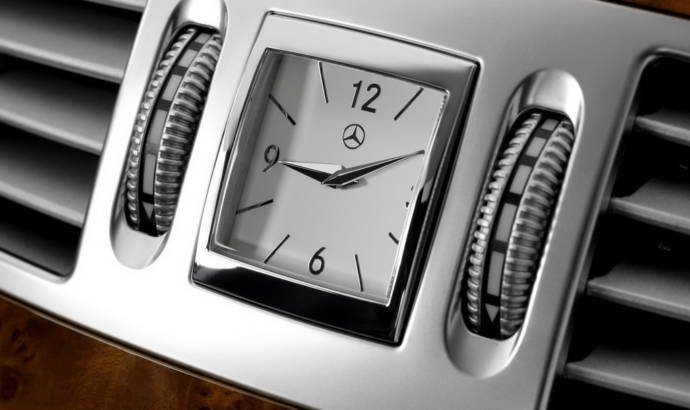
05 Jul 2010
0

